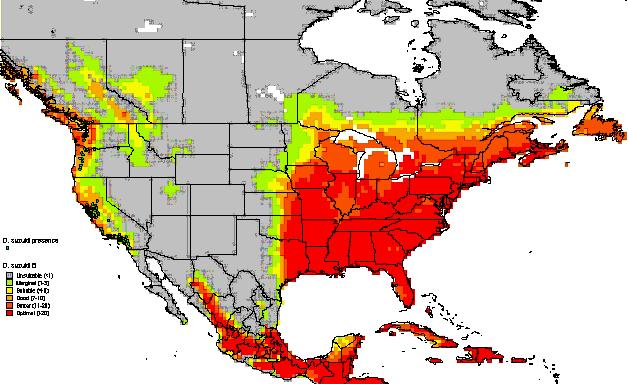| | Background | Appearance | Distribution | Hosts | Damage | Life Cycle | Management | Contact Information
Background
Spotted wing drosophila (Drosophila suzukii), a serious new fruit fly pest of soft fruit and berries, was first identified in Alberta in 2010. Spotted wing drosophila is a temperate fruit fly, native to Southeast Asia; preferring temperatures of 20-30o C. It is known to infest thin-skinned fruit. Many species of fruit flies are present in late summer; most normally infest overripe, fallen, decaying fruit, so are not crop-limiting pests. However, a spotted wing drosophila female lays her eggs inside sound fruit before harvest with her saw-like ovipositor, which contaminates fruit with larvae, and causes it to become soft and unmarketable.
Appearance
Many features are typical for Drosophila fruit flies, with a few key differences. Male and female characteristics are key identifiers for this species. Please see the attached links at the bottom of this Factsheet.
Adults: 2-3 mm (1/8 inch) long, brownish with red eyes and clear fly-like wings. Compared to other fruit flies, D. suzukii is a robust fly, but this is difficult to discern unless compared directly to other species. Males have a black/grey spot on the end of each wing (see attached link), as well as two black ‘combs’ or bands on the front legs. The females do not have spots or leg bands. Females have saw-like ovipositors that are used to cut into fruit skin (see attached link). Ovipositors are easier to see when extended. A hand-lens or dissecting microscope is needed to confirm ovipositor presence.
Eggs: 0.6 mm long, oval, white, 2 filaments at one end .
Larvae: Legless, headless, up to 6 mm long at maturity, white or transparent .
Pupa: 3 mm long, brown, football-shaped, two stalks with small finger-like projections on one end .
Refer to the Identification Guide for Spotted Wing Drosophila (see below) for additional information on characteristics of this pest.
Distribution
Asia: Burma, China, India, Japan, Korea, Russia (far east), Thailand
Canada: British Columbia, Alberta, Ontario, Quebec, Nova Scotia
USA: California, Oregon, Washington, Florida, Hawaii, Michigan, North & South Carolina, Louisiana, Utah
Europe: Spain, Russia, France, Italy, Portugal, Germany
Climex model showing areas that could be favorable to SWD.

Hosts
In reports from British Columbia, spotted wing drosophila has been confirmed infesting wild and cultivated raspberry and blackberry (Rubus), blueberry (Vaccinium), strawberry (Fragaria), table grape (Vitis), cherry, peach, nectarine, apricot, plum (Prunus), and suspected in hardy kiwifruit (Actinidia). Wild hosts confirmed include Oregon grape (Mahonia aquafolium), elderberry (Sambucus), currant (Ribes), dogwood (Cornus kousa), mulberry (Morus), salmonberry (Rubus spectabilis), thimbleberry (Rubus parviflorus) and salal (Gaultheria shallon).
Damage
Females lay eggs under the skin of ripe fruit shortly before harvest. Larvae hatch and begin to feed within the fruit, causing softening in the area of feeding. There can be several larvae in a fruit, which hastens softening and fruit collapse. Holes the size of pin pricks are evident within the soft areas of infested fruit . These holes result from egg laying and are used as breathing holes by larvae. In addition, these holes provide entry points for diseases such as brown rot and botrytis.
Life Cycle
Spotted wing drosophila emerge in the fall overwinter as adult flies. In spring flies become active, mate and lay eggs in ripening fruit. Based on climate model predictions, there could be 2 generations per year in Alberta Generations will likely be overlapping as flies are relatively long-lived particularly at temperatures of 20°C and cooler. Based on Japanese research/publication, oviposition lasts 10-59 days, with 7-16 eggs laid per day, and averaging 384 eggs per female. Eggs hatch in 2-72 hours, larvae mature in 3-13 days, and pupae reside in fruit or outside of fruit for 3-15 days. In the lab at constant temperature, one generation takes 50 days at 12°C, 21-25 days at 15°C, 19 days at 18°C, 8.5 days at 25°C, and 7 days at 28°C. Adults are also attracted to dropped and decaying fruit and will feed on it.
How it Spreads
Spotted wing drosophila adults can be blown by wind to nearby locations. However, long distance dispersal is expected to be achieved by transportation of infested fruit to new regions. Non-fruit bearing plants are not considered to be of significant risk to transport this pest.
Management
Management recommendations include good harvest and sanitation practices, such as culling soft fruit, burying culls, and keeping processing areas and equipment free of old fruit. Emergency registration products approved for the control of spotted wing drosophila in Alberta for the 2013 season are Delegate (spinetoram), Entrust (spinosad), Malathion (malathion), Pyganic (pyrethrins) and Ripcord (cypermethrin). Both Entrust and Pyganic are acceptable for organic crop production.
Quarantine Regulations
This pest is not regulated in the United States and Canada. The regulatory status of this fly in other countries should be checked with packers.
Surveillance
In 2011 to 2013 surveillance sites for flies were operated from June to October in Alberta. Surveillance continues in fruit growing regions of Alberta in 2013 to determine when SWD flies are present or active in fruit producing areas.
Spotted wing drosophila flies can be monitored with apple cider vinegar baited traps. Other bait types will work but currently Alberta experience indicates that apple cider vinegar is easy to use and effective. Suspect fruit can be collected and inspected for larvae. Adult flies are needed to confirm species. Spotted Wing Drosophila Monitoring Report (link below) for further information on trapping and for updates on the surveillance programs.
If you think you have this pest, contact
- Alberta AgInfo Centre at 310-FARM (3276)
Links for Spotted Wing Drosophila identification:
|
|